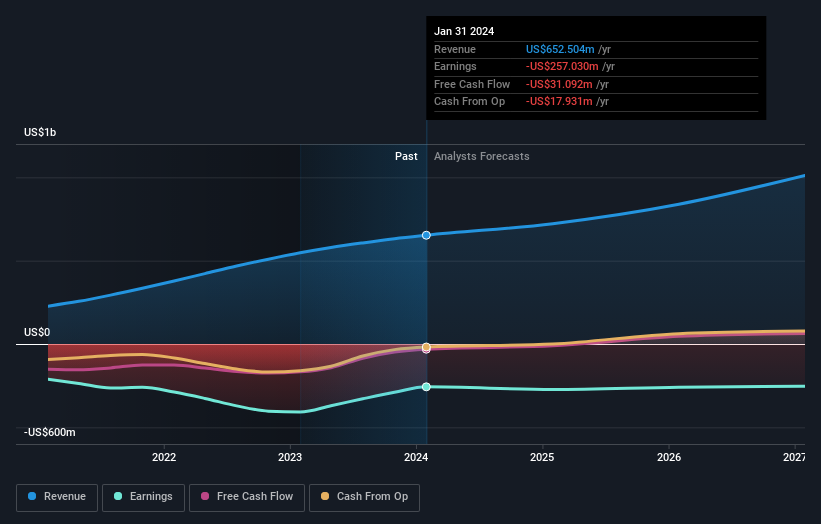Here's What Analysts Are Forecasting For Asana, Inc. (NYSE:ASAN) After Its Annual Results
It's been a mediocre week for Asana, Inc. (NYSE:ASAN) shareholders, with the stock dropping 12% to US$16.26 in the week since its latest yearly results. Revenue hit US$653m in line with forecasts, although the company reported a statutory loss per share of US$1.17 that was somewhat smaller than the analysts expected. This is an important time for investors, as they can track a company's performance in its report, look at what experts are forecasting for next year, and see if there has been any change to expectations for the business. We thought readers would find it interesting to see the analysts latest (statutory) post-earnings forecasts for next year.
View our latest analysis for Asana
Taking into account the latest results, the consensus forecast from Asana's 18 analysts is for revenues of US$721.8m in 2025. This reflects a solid 11% improvement in revenue compared to the last 12 months. Losses are expected to hold steady at around US$1.15. Yet prior to the latest earnings, the analysts had been forecasting revenues of US$716.2m and losses of US$1.24 per share in 2025. It looks like there's been a modest increase in sentiment in the recent updates, with the analysts becoming a bit more optimistic in their predictions for losses per share, even though the revenue numbers were unchanged.
There's been no major changes to the consensus price target of US$20.02, suggesting that reduced loss estimates are not enough to have a long-term positive impact on the stock's valuation. It could also be instructive to look at the range of analyst estimates, to evaluate how different the outlier opinions are from the mean. There are some variant perceptions on Asana, with the most bullish analyst valuing it at US$28.00 and the most bearish at US$10.00 per share. This is a fairly broad spread of estimates, suggesting that analysts are forecasting a wide range of possible outcomes for the business.
Of course, another way to look at these forecasts is to place them into context against the industry itself. We would highlight that Asana's revenue growth is expected to slow, with the forecast 11% annualised growth rate until the end of 2025 being well below the historical 35% p.a. growth over the last five years. Compare this to the 431 other companies in this industry with analyst coverage, which are forecast to grow their revenue at 12% per year. So it's pretty clear that, while Asana's revenue growth is expected to slow, it's expected to grow roughly in line with the industry.
The Bottom Line
The most obvious conclusion is that the analysts made no changes to their forecasts for a loss next year. They also reconfirmed their revenue estimates, with the company predicted to grow at about the same rate as the wider industry. There was no real change to the consensus price target, suggesting that the intrinsic value of the business has not undergone any major changes with the latest estimates.
Following on from that line of thought, we think that the long-term prospects of the business are much more relevant than next year's earnings. We have forecasts for Asana going out to 2027, and you can see them free on our platform here.
You still need to take note of risks, for example - Asana has 3 warning signs we think you should be aware of.
Have feedback on this article? Concerned about the content? Get in touch with us directly. Alternatively, email editorial-team (at) simplywallst.com.
This article by Simply Wall St is general in nature. We provide commentary based on historical data and analyst forecasts only using an unbiased methodology and our articles are not intended to be financial advice. It does not constitute a recommendation to buy or sell any stock, and does not take account of your objectives, or your financial situation. We aim to bring you long-term focused analysis driven by fundamental data. Note that our analysis may not factor in the latest price-sensitive company announcements or qualitative material. Simply Wall St has no position in any stocks mentioned.

